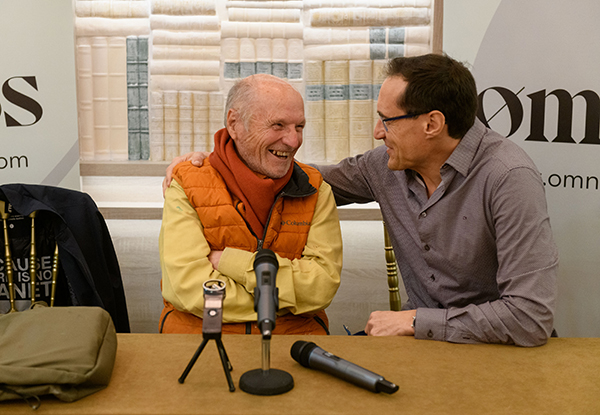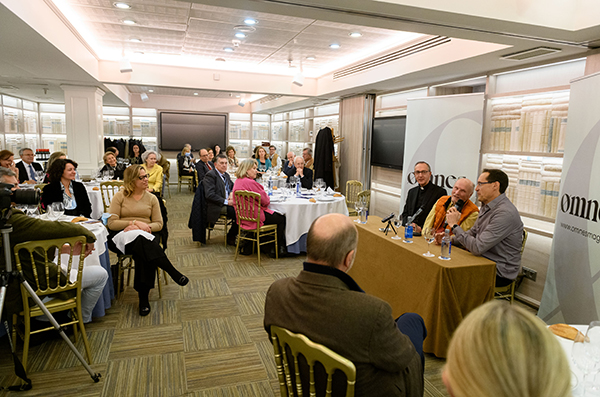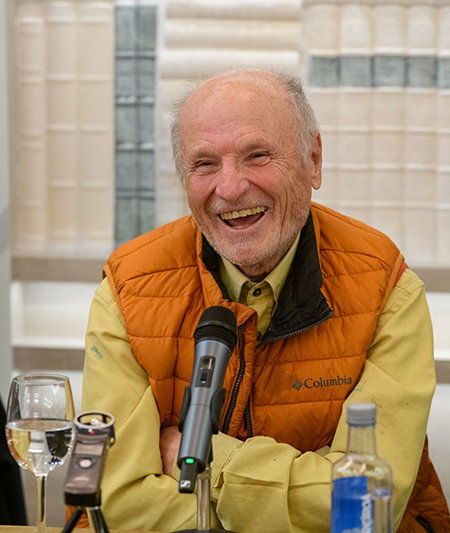Antonio López, master of Spanish realism, is one of the most recognized painters and sculptors of the Spanish artistic scene. He is a native of Tomelloso, where he was born in 1936. Together with friends, collaborators and those close to Omnes, he shared a dinner and a lively discussion last Friday in Madrid.
The meeting started with an introduction and welcome by Jorge Latorre, Professor of Art History at the Universidad Rey Juan Carlos de Madrid who, during the meeting, combined, in a natural way, the memories of the painter and the numerous questions from the audience.
"My uncle changed my life."
One of the most important names in Antonio López's life, as he himself explained, was his uncle, the painter Antonio López Torres, whom he defined as "a truly extraordinary painter". It would be López Torres who changed the course of the life of the boy from Tomelloso when "at the age of 13, he convinced my father and I came to Madrid to prepare to enter Fine Arts. At that time I was preparing to work in an office... That changed my life. After that, it is like being Mozart's nephew, it was the strength, the presence and the example that sustains you".


"I have arrived at my place."
The arrival in Madrid meant a radical change in the life of the painter who, at the age of 14, arrived in a big city "full of cars, with many priests" and where he began to paint to prepare for the entrance to Fine Arts. In Madrid "I met people who, like me, wanted to be painters or sculptors, and I met my family. I thought 'I've arrived at my place'.
The time in Madrid and the study of Fine Arts was, in López's words, "the most wonderful time of my life". In Madrid he met Mari, his wife, and was fascinated by the classical art that he painted and copied thanks to the reproductions that, at that time, could be seen in the Casón del Buen Retiro.
With a certain irony, the painter recalled that "although I knew very little about art, I had a great instinct to know who among my classmates knew the most. We didn't trust the teachers very much. We would have needed them to talk to us about modern art. When I started to know more, I realized that art was a mystery and how do you get in there, who gives you the key? The teachers, then, were not ready for that, they were overwhelmed by the times. There was no Picasso, Paul Klee, Chagall... That's what we dreamed of.
I realized that art was a mystery, and how do you get in there, who gives you the key?
Antonio López. Painter
"For me, for example, I had no trouble understanding modern art, but it was very difficult for me to understand Velázquez, or the great Spanish art of the Baroque. When I understood modern art I understood the art of the Prado Museum, not the other way around. That's why I think that in fine arts schools you have to teach first what is done in the moment in which you live".


Before the gift received, give thanks
The varied questions from the audience were an opportunity for the painter to share his memories, reflections and opinions on pictorial trends, the role of the artist, the importance of the spectator and his experiences of faith through art.
In response to a question about expressionism or the image of the "tormented artist", Antonio Lopez said that "the cliché that artists are sad people is horrifying, we have to say no. I think other people live worse than we do, because artists are motivated by a job we like. I think other people live worse than we do, because we artists are motivated by a job we like. If you can live from it, of course. I see the news and I get scared. I think life is worse than art. Art seems to me a beauty for life". In this sense, he stressed that "I have experienced art as a liberation. The one who starts with the will to learn finds the best of life. I think it is a torture in the case of the painter, musician, filmmaker..., who does not find an audience, but sometimes what I see in the faculty or in the workshops are people who are there wrong and should not be there".
Antonio López also wanted to remind us that you have to have the strength to dedicate yourself to the artistic field because "in art everyone has doubts, but now, painters, for example, have the freedom to do what they like. Until Goya, painters used to make commissions, they lived depending on the commissions. Not now. Before the artist was a servant of society, now also, but the first step is taken by him".
If it is a matter of transmitting what is religious, what is necessary is to feel it. If you feel it, you transmit it.
Antonio López. Painter
"I am a man of faith"
"I am a man of faith," Antonio López repeated on several occasions. In this sense, he spoke of his visits to the Prado and the contemplation of that "great religious art" that he found difficult to understand. When asked about a painting that reflected his faith, Antonio López stated categorically: "The Crucified Christ by Velázquez". This work, he stressed, "wonderfully reflects religious art. I think there is no other figure of Christ crucified at that level. So immense, so real and so supernatural. Velázquez looked at a body and I don't know what he did, but he made a God. It is a miracle.
The painter wanted to point out, in this area, that religious art has to lead to prayer, that is why he admires "popular art, the carvings of the virgins: the Rocío, the Macarena... Those dressed virgins that the people decorate and put jewels on them, all that seems subjugating to me because it is not distracted in making art. He goes directly to the religious and he gets it right. If you try to transmit the religious, what you need is to feel it. If you feel it, you transmit it. Velázquez achieves it in this Christ in an impressive way".
Emotion has created art
Who creates art? Art historian Ernst Gombrich said that art does not exist but artists do. Antonio Lopez defends something similar when he emphasizes that the creator of art is emotion: "when I am in the Puerta del Sol painting, it is expected of me, and I hope, that there is something more than a reproduction of the Puerta del Sol, because for that we have a photo". That more, said Lopez, is "to capture the emotion, the important thing is the emotion. Emotion is what justifies art. Once the emotion is there, language doesn't matter." "Emotion is what created art. I believe that the painters of Altamira made those paintings because something in nature caught their attention... and it is not the emotion of the painter but the emotion of the beholder."
When I am at the Puerta del Sol painting, I am expected, and I hope, that there is more than just a reproduction of the Puerta del Sol.
Antonio López. Painter
"Art has arisen from a need of man, like religion, I believe they go together. My starting point is precision. I measure things so that the proportion is exact... at the beginning I do things as a craftsman and then there comes a moment when it is the painting that speaks, that makes it have something that photography does not have, something that belongs to me. If it doesn't have that, it will be a display of skill but it is not an art that transmits emotions, like the great art from Bach to flamenco".


The dinner, which continued throughout the evening, culminated with the presentation of the Omnes multiplatform project to those present and a few words from Jorge Beltrán, member of the board of trustees, as well as a small raffle.
As is well known, the launch of omnesmag.comThe first of the year, the information and analysis portal on the Church, was launched by the Roman Academic Center Foundation (CARF). In addition, the Omnes magazine continues its monthly publication, along with various forums and thematic meetings with personalities from different disciplines, and the publication of periodic newsletters, such as The Compass.












